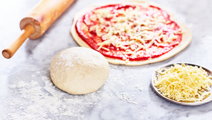
Margherita pizza

Instructions
Dough
Baked tomatoes
Tomato sauce
Pizza
FAQ: Questions about Margherita pizza
Discover the art of Italian cooking with our authentic pizza Margherita recipe. We answer your most common about this beloved classic, making sure every slice captures the true flavours of Italy.
Ingredients
Dough
Yeast | 50 g |
|---|---|
Lukewarm water | 500 ml |
| 50 ml | |
Flour | 1200 - 1300 ml |
Flake salt | 2 tsp |
Baked tomatoes
Cocktail tomatoes, preferably in different colours | 300 g |
|---|---|
Olive oil | 1 tbsp |
Salt | ½ tsp |
Sugar | ½ tsp |
Tomato sauce
Whole tomatoes, preferably San Marzano tomatoes | 1 can |
|---|---|
Olive oil | 2 tbsp |
Dried oregano | 1 tsp |
Salt | 1 tsp |
Topping
Mozzarella cheese, grated | 300 g |
|---|---|
Balls of buffalo mozzarella | 3 |
Fresh basil | 1 pot |
Tips: Making the best Margherita pizza
Get as close to the real Neapolitan pizza as possible with our tips for the dough, which is the alpha and omega for the finished pizza.
Getting the right pizza dough consistency
Achieving the right consistency in pizza dough is crucial and starts with the correct flour-to-water ratio, ideally around 65 % hydration for our recipe. Use high-protein bread flour or '00' flour, which absorbs more water and offers greater elasticity. Mix your ingredients gently, dissolving yeast in water before adding flour and oil. Knead the dough until smooth and slightly sticky, about 10–15 minutes, to develop the gluten, which is essential for a stretchable, workable dough.
Rest for the dough
After kneading, the dough must rest and rise properly. Allow it to rise in a warm, draft-free area until it doubles in size. This first rise is crucial for flavour development and gluten structure. If the dough was refrigerated, let it rest at room temperature for at least 30 minutes before shaping. This relaxation period makes the dough less elastic and easier to shape without snapping back.
Stretching the dough
Proper stretching is essential for achieving the characteristic thin centre and thicker edges of Neapolitan pizza. Start by gently flattening the rested dough ball into a disk using your fingers, not a rolling pin, to preserve the air pockets. Then, drape the dough over your knuckles and carefully stretch it by rotating and expanding the dough using gravity. Aim for even thickness and avoid tearing, ensuring the edges remain slightly thicker to form the traditional crust.
Ensuring optimal oven heat
Margherita pizza requires a high-temperature oven, ideally between 225–260°C. If using a home oven, preheat it with a pizza stone, pizza steel, or baking tray inside for at least 30 minutes to ensure it is thoroughly hot. This intense heat is vital to achieve a crispy crust and properly melted cheese in just a few minutes, replicating the environment of a traditional pizza oven.
Rotate your pizza for even cooking
To ensure your pizza cooks evenly, rotate it halfway through the baking process. In a home oven, the back often gets hotter than the front, so rotating the pizza ensures that all parts receive equal heat exposure. This helps avoid uneven cooking and ensures that the crust browns nicely all around. If using a pizza stone or steel, use a pizza peel to rotate it more easily.
Make a classic Italian Margherita pizza
Step into a slice of culinary history with our classic Italian Margherita pizza. As you slice the pizza, mozzarella stretches into silky strands, sauce bubbles in the crust, and the scent of basil greets you. This is pizza at its purest, needing no extras to impress and showcasing just how delicious a traditional Neapolitan pizza can be.
Crispy crust with tomato sauce, mozzarella, and basil
The thin, hand-stretched dough forms a delicate base with a satisfying crunch and a soft, airy rim, known as the cornicione. The vibrant, homemade tomato sauce, seasoned with a touch of oregano, lays the foundation. Topped with creamy buffalo mozzarella and a sprinkle of fresh basil, this pizza pays homage to Italian pizzaiolos’ centuries-old art of pizza making. The result is a dish that is rustic yet refined, with bold, comforting flavours.
Our version not only celebrates the classic elements but elevates them with the addition of succulently baked tomatoes. After roasting to intensify their flavour and sweetness, these colourful cocktail tomatoes add a rich depth to the vibrant tomato sauce base.
The perfect pizza to share with friends and family
The simple but high-quality ingredients are what make this pizza ideal for having guests over. Share it with friends and family and enjoy how everyone, of course, loves the savoury tomato sauce, mozzarella cheese, and fresh basil. The flavours are fresh and light, making it suitable for both lunch and dinner, served under a clear summer sky as well as in the warm indoors in winter.
The easy preparation also makes it ideal for guests. Prep the dough when you have the time, and let it rest until you are ready to add the toppings. This means you can spend more moments enjoying the company of those around you. Serve it family-style with a big pie in the middle of the table, or make smaller pies so each person gets one.
We have other delicious recipes that you can gather around and share with friends and family. For example, a spicy chilli sin carne, jambalaya with chicken and chorizo, or sumptuous cheese fondue. You can also make a different type of pizza, namely, our Turkish pizza with lamb and pickled red onions.
Put your own spin on it
You can easily vary the recipe while maintaining pizza Margherita’s characteristic simplicity. Consider adding mild but flavourful toppings such as olives, roasted red peppers, or droplets of fresh basil pesto. Maybe just one or two extra toppings at a time so they complement the traditional flavours without taking centre stage. If you are keen on a more aromatic touch, sprinkle finely chopped garlic or rosemary into the sauce or directly onto the cheese before baking. For those who enjoy a bit of heat, top with a few thinly sliced jalapeños.
For a more pungent addition, add chargrilled artichokes or spicy sausages such as salsiccia, nduja, or pepperoni. These bolder choices integrate seamlessly with the basic ingredients of a Margherita, allowing for a personalised taste experience while still honouring the pizza’s original spirit.
Consider pairing your Margherita pizza with a flavourful crust dip. Mix olive oil with minced garlic, rosemary, and a pinch of salt for a simple yet delicious dip. Alternatively, blend roasted red peppers and mushrooms to create a rich, savoury dipping sauce, or use a simple, classic basil pesto.











